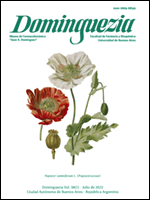Morphoanatomic study of two species commercialized as "topasaire" or "tupisaire" in Jujuy province, Argentina
Keywords:
folk medicine, micrograph, pharmacobotany, topasaire-tupisaireAbstract
Argyrochosma nivea (Poir.) Windham (Pteridaceae) and Gaillardia megapotamica (Spreng.) Baker (Asteraceae), are species used in the folk medicine that are sold in urban areas as "topasaire" or "tupisaire". The objective of this work it is to provide characters of diagnostic value to differentiate both species when they are expended in pieces form. The micrographic method was used for the analysis of dry commercial samples. At the morphoanatomic level, A. nivea var. nivea has fronds with 2-3 imparipinnate blades; orbicular pinnules, ovate or elliptical, short petioled; glandular hairs producing white waxes on abaxial face; trilete spores light to dark brown; isodiametric to rectangular lobed epidermal cells with sinuous walls; actinocytic, anisocytic, paracytic and diacytic stomata. G. megapotamica var. radiata has alternate pinnatisect lanceolate leavest; radiate capitulum, with yellow flowers; smooth-walled and polyhedral cells; anomocytic and actinocytic stomata, the former being the most frequent; calcium oxalate crystals; tricolporate echinate pollen grains; multicellular eglandular hairs with pointed end apical cell; sessile glandular trichome with bicellular head; glandular, capitate biseriate hairs. It is concluded that the described morphoanatomical characteristics provide information of diagnostic value for the pharmacobotanical quality control of the commercial samples, especially when they are chopped.



